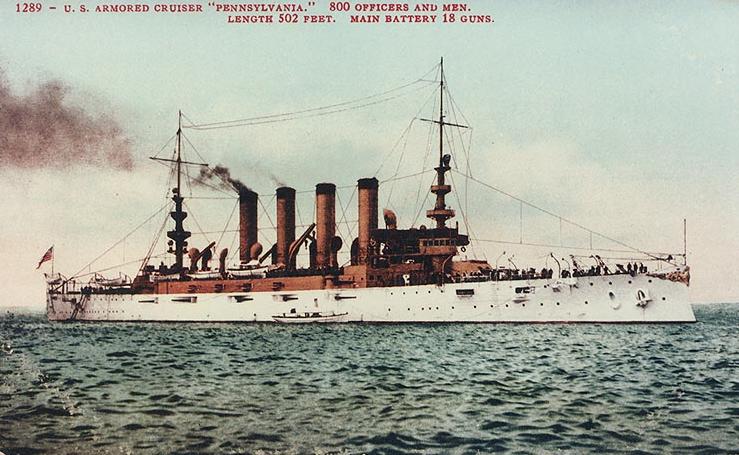 She was an aviation pioneer.
She was an aviation pioneer.She saw the end of the pre-Dreadnought era and tried to pick a fight in WWI.During the winter of 1910-1911, a plane landed on and took off from a platform constructed on her afterdeck, opening the era of naval aviation. At the Mare Island Navy Yard, California in January 1911 she was fitted with a temporary wooden deck in preparation for Eugene Ely's airplane landing attempt. Upon completion of her flight deck Pennsylvania cruised to San Francisco Bay, California, where she anchored for the Eugene Ely's historic flight. Ely landed his Curtiss pusher biplane on board the ship on the morning of 18 January 1911, the first airplane landing on a warship. The landing deck, 120 feet long and 30 feet wide, was inclined slightly to help slow the plane as it landed, and had a thirty-degree ramp at its after end. She then sailed to San Diego Bay, California, and on 17 February 1911 additional test flights were conducted. Glenn Curtiss the designer of the Curtiss Hydroaeroplane was on board for these tests.
Around the end of June 1918 Pittsburgh and the USS Vermont were patrolling the waters off Antofagasta, Chile protecting American interests and preventing Austrian and German ships from sailing. It was during the last week of June that the USS Radnor a US Navy cargo ship made port in Antofagasta, Chile on the 28th of June, but due to she being a US Navy ship tensions were high in Antofagasta and the Radnor was ordered out of the harbor by the German ambassador or she would be interned in port. Lt. Comdr. Marcus S. Harloe, Captain of the Radnor radioed for help and the USS Vermont and USS Pittsburgh answered the call. Radnor readied for sea in a hurry and Vermont and Pittsburgh arrived and escorted Radnor to safety before hostilities started.And like another FbF boat, was an old China Hand.
She sailed on 16 October for Chefoo, China arriving there on 23 December 1926. Early in January of 1927, she landed sailors and Marines to protect Americans and other foreigners in Shanghai from the turmoil and fighting of the Chinese power struggle. When Chiang Kai-shek's Cantonese Army won control of Shanghai in March 1927, Pittsburgh resumed operations on patrol and exercises with the Asiatic Fleet. On 28 March 1928 Pittsburgh was in Hong Kong, China according to post cards mailed from the ship and cancelled with Hong Kong postmarks.I think she deserves some time.In the book “The Sand Pebbles” by Richard McKenna, which was also made into the famous movie by the same name starring Steve McQueen there is a passage that refers to the USS Pittsburgh. McKenna wrote this book, which tells the story of the men in the US Navy known as “China Sailors” of 1926. This was also the beginning of the start of the Pittsburgh’s tour as Flagship of the Asiatic Fleet from 1926-1931. It refers to something that happened while in South America several years previous, which is likely to be the murder that took place on the Pittsburgh during January of 1918 while the Pittsburgh was in Rio de Janeiro, Brazil.
In those days “China Sailors” were clearly regarded in a poor light. In the movie “The Sand Pebbles” Jake Holman played by Steve McQueen tells Shirley Eckert (Candice Bergen) “…nice American girls don’t talk to China Sailors.” Even the local Chinese mock them and their superior officers treat them badly and the people whom they protect regard them as an embarrassment. McKenna reminds us in his book that the US Navy of the 1920’s was not necessarily seen as a career (except by the officers), but often as a means of escape or even punishment for the lowly China Sailor.
This may help explain the following reference form McKenna’s book, in which the implication was that the Pittsburgh had a bad reputation, with one character saying “I would rather have my sister in a whorehouse then have my brother serve on the USS Pittsburgh.” A second sailor replied, “I would rather have your brother.” In the book, the next day the second sailor received a warning in the form of a scrap of canvas with a pile of wet sand on it. This canvas warning likely refers to the old tradition in the navy known as “cobbing” or being beaten with a stocking filled with wet sand. There was no doubt that to the sailor who received the sand on his bunk that this was an old seagoing warning and that the message was very clear.
Hat tip Tim.









No comments:
Post a Comment